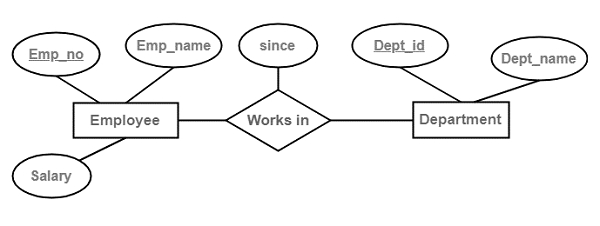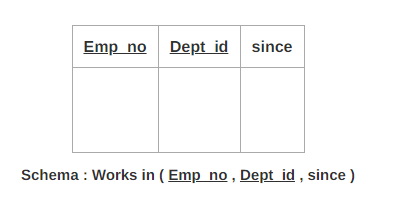
 Data Structure
Data Structure Networking
Networking RDBMS
RDBMS Operating System
Operating System Java
Java MS Excel
MS Excel iOS
iOS HTML
HTML CSS
CSS Android
Android Python
Python C Programming
C Programming C++
C++ C#
C# MongoDB
MongoDB MySQL
MySQL Javascript
Javascript PHP
PHP
- Selected Reading
- UPSC IAS Exams Notes
- Developer's Best Practices
- Questions and Answers
- Effective Resume Writing
- HR Interview Questions
- Computer Glossary
- Who is Who
Explain the conversion of ER diagrams to tables in DBMS?
Entity relationship diagram is the graphical representation of entities and relationships among those entities in the database.
Example

Conversion of ER diagrams to tables
Follow the steps given below for the conversion of the ER diagrams to tables in the database management system (DBMS) −
Step 1 − Conversion of strong entities
For each strong entity create a separate table with the same name.
Includes all attributes, if there is any composite attribute divided into simple attributes and has to be included.
Ignore multivalued attributes at this stage.
Select the p key for the table.
Step 2 − Conversion of weak entity
For each weak entity create a separate table with the same name.
Include all attributes.
Include the P key of a strong entity as foreign key is the weak entity.
Declare the combination of foreign key and decimator attribute as P key from the weak entity.
Step 3 − Conversion of one-to-one relationship
For each one to one relation, say A and B modify either A side or B side to include the P key of the other side as a foreign key.
If A or B is having total participation, then that should be a modified table.
If a relationship consists of attributes, include them also in the modified table.
Step 4 − Conversion of one-to-many relationship
For each one to many relationships, modify the M side to include the P key of one side as a foreign key.
If relationships consist of attributes, include them as well.
Step 5 − Conversion of many-many relationship
For each many-many relationship, create a separate table including the P key of M side and N side as foreign keys in the new table.
Declare the combination of foreign keys as P for the new table.
If relationships consist of attributes, include them also in the new table.
Step 6 − Conversion of multivalued attributes
For each multivalued attribute create a separate table and include the P key of the present table as foreign key.
Declare the combination of foreign key and multivalued attribute as P keys.
Step 7 − Conversion of n-ary relationship
For each n-ary relationship create a separate table and include the P key of all entities as foreign key.
Declare the combination of foreign keys as P key.
Table
After successful conversion, the result will be as follows −


